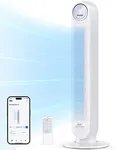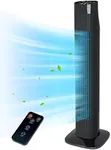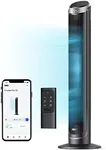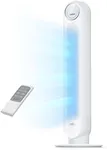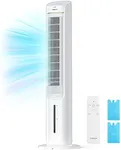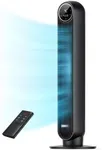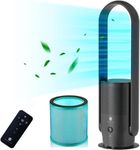Buying Guide for the Best Cold Air Tower Fan
Choosing the right cold-air tower fan can make a significant difference in your comfort, especially during hot weather. Tower fans are popular because they are space-efficient, stylish, and effective at circulating air. When selecting a tower fan, it's important to consider several key specifications to ensure you get the best fit for your needs. Here are the main specs to look at and how to navigate them.AirflowAirflow is the amount of air the fan can move, usually measured in cubic feet per minute (CFM). This spec is important because it determines how effectively the fan can cool a room. Higher CFM values mean more powerful airflow. For small rooms or personal use, a lower CFM (around 200-300) might be sufficient. For larger rooms or more intense cooling, look for a fan with a higher CFM (400+). Consider your room size and how much cooling you need to pick the right airflow.
Noise LevelNoise level, measured in decibels (dB), indicates how loud the fan will be when operating. This is important if you plan to use the fan in a bedroom, office, or any other quiet space. Fans with noise levels below 50 dB are generally considered quiet. If you are sensitive to noise or need the fan for a quiet environment, look for models with lower dB ratings. For areas where noise is less of a concern, you can opt for fans with higher noise levels.
OscillationOscillation refers to the fan's ability to rotate from side to side, distributing air more evenly throughout the room. This feature is important for ensuring that the cool air reaches all corners of the space. Fans with a wider oscillation range (70 degrees or more) can cover larger areas more effectively. If you need to cool a larger room or want more even air distribution, choose a fan with a wide oscillation range. For smaller spaces, a narrower range may suffice.
Speed SettingsSpeed settings allow you to adjust the fan's airflow to your preference. This is important for customizing your comfort level. Most tower fans come with at least three speed settings (low, medium, high). Some models offer additional settings or even variable speed control. If you like having precise control over airflow, look for fans with more speed options. For basic use, three settings are usually adequate.
TimerA timer feature allows you to set the fan to turn off automatically after a certain period. This is useful for saving energy and ensuring the fan doesn't run all night or while you're away. Timers can range from 1 to 12 hours. If you want the convenience of automatic shut-off, look for a fan with a timer that suits your schedule. For example, if you use the fan while sleeping, a timer with a longer range (6-8 hours) might be ideal.
Remote ControlA remote control allows you to adjust the fan's settings from a distance, adding convenience. This is particularly useful if you plan to place the fan in a hard-to-reach spot or if you want to change settings without getting up. If convenience is a priority for you, look for models that include a remote control. For those who don't mind manual adjustments, this feature may be less critical.
FilterSome tower fans come with built-in air filters that can help remove dust, pollen, and other particles from the air. This is important for improving air quality, especially if you have allergies or respiratory issues. If air quality is a concern, look for fans with HEPA or other high-efficiency filters. For general cooling purposes, a fan without a filter may be sufficient.
Design and SizeThe design and size of the fan can affect both its aesthetic appeal and its practicality. Tower fans come in various heights and styles, so it's important to choose one that fits your space and decor. Taller fans can distribute air more effectively in larger rooms, while shorter fans might be better for smaller spaces. Consider where you plan to place the fan and how it will fit with your room's layout and style.

